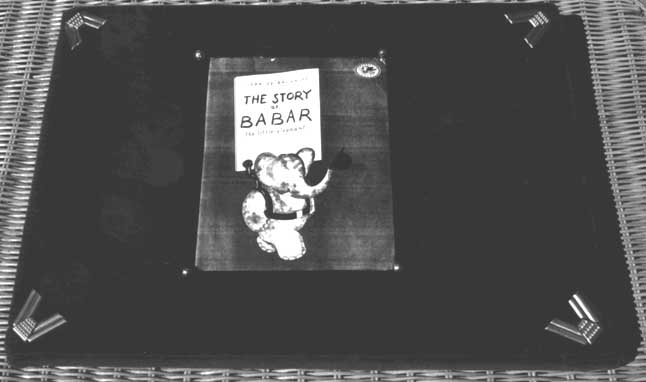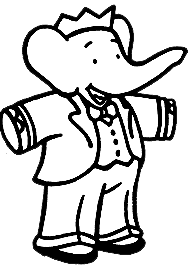M a r t i n X S. X G o t f r i t XXXXXXXX[works]
S X t X o X r X y XXX T X i X m X e

[concert documentation of premiere available here]
Background
Story Time was commissioned by Vancouver ProMusica in the Spring of 1997. My sons were just turning three and reading stories occupied a great deal of our time together. Of the large library of children's books I was most fascinated by those written between the two World Wars. These hand drawn books, both charming and somewhat quaint, also spoke clearly of many early 20th century concerns: the new ÒmodernÓ technology, the redefining of roles within family and society and European colonialism. In two of the most famous children's book series: Curious George and Babar the Elephant, much can be read and seen about the Eurocentric view of the world in the mid 30's. Fascinating to the young listener, the older and cynical reader finds much that is funny, disturbing and telling of who we were as a culture when these books were first drawn.
 Story Time:
Story Time:
Of all the books to choose from, I decided upon the first book by Jean de Brunhoff: The Story of Babar, published in 1933. For the adult reader, the story is a complex mix of fairy tale and Dadaesque events and thus was well suited for a performance piece. Even without the images, the story survives its translation to the stage.
In Story Time I take the role of both reader and listener - sitting in a chair while holding a large Òpicture bookÓ. (The cover is pictured above).
The notion driving the piece is that the computer1 would both tell the story and provide a musical accompaniment. By pressing buttons built into the book/interface I could advance the story and guide the music. Wishing to complete the experience of my reading at home, I also included the voice samples of several of my boy's talking toys2 whom I could trigger to comment upon and interrupt the reading. I also added some samples of real elephants to the cacophony.
During the performance I sat in front of the computer and pressed buttons hidden below the surface of the inside of the book3. (Pictured above) I could request that the next fragment of the story be played (samples of me reading from the text), be replayed, be played backwards or stopped. Software written in an application called MSP performed real-time processing of these samples4. I was able to alter this processing only by repeating or pausing the text playback. In addition I could select any of the talking toys to comment ("Things were fuzzy until I got glasses" (Arthur), "You're my best friend", "I love you"(Barney), "Can you find your favorite animal?" (Hands), etc. or have the real elephants trumpet. The music was generated by an 8 voice MIDI generator controlling a Proteus with a large collection of custom presets. I could not direct the music but I could ask the system to change what it was doing. I could also specify how dramatic or subtle the change would be on a scale from 0.0 to 1.0. The work was essentially a structured improvisation, where serendipity could sometimes work wonders: a strange detuned horn fanfare when Babar returns in triumph to become King, or a melancholy woodwind and string chorale when Babar leaves his dear friend "the old lady". After much rehearsal I began to learn how to (occasionally) predict and repeat some of these wonderful chance occurrences - though the system's surprises were always most interesting and challenging.
8 Voice: The MIDI Player
This main window of 8 Voice is designed to viewed easily during performance. Through the book interface,
á changes can be made to the scale range (MIDI note numbers),
á the tempo range (the program selects the actual tempo),
á the % rest or % of events that will be silent,
á the % that will be staccato,
á the range of velocity,
á a rhythm probability (20 - from 1/4 notes only to fast chaos!),
á a preset (6) which alters the real-time MIDI characteristics of the synthesizer (in the example above, changes to pitch bend and cross fades between two different samples),
á a scale or mode (from 20) - C Harmonic Minor in this example,
á a rate of change or Ä value for all changes and one specifically for determining scale steps, (in both cases 0.10 represents subtle shifts and 0.90 means radical changes)
á an overall volume setting reflecting , fade ins, fade outs as well as crescendos, etc.,
á a set of 15 timbre collections or synthesizer preset numbers ( abstract voices with slow attacks seen above) and
á choosing a subset of the eight voices to be silent.
Story Teller
This window displays the story teller. Ã indicates which story fragment is being played while "read" indicates the sample now in memory. Pitch, and various comb filter parameters are altered by 13 different behaviours or groups of constrained random numbers.
Composer's Statement
Story Time represents another step in my research into live performance of electroacoustic music. It is a good illustration of the progress I have been making in reducing the number of user controls for algorithmic composition system without sacrificing the musical interests of the user. This "distilling" of many parameters down to an essential (and manageable) few is essential for live performance applications. My goal is to create an interface (both hardware and software) not unlike a conventional musical instrument, that is, a system with relatively few controls which provides a wide variety of musical expression.
Story Time also is the first piece of mine to feature the use of MSP, a Max overlay (application) which allows access to digital signal processing (DSP) in a graphic programming environment.
Lastly, Story Time represents another important milestone for me: it is my first major work that is funny.
Notes
1. Story Time was developed on a G3 233 using Max 3.59 and MSP. Funding for this research was provided by the SSHRC through Simon Fraser University.
2. Barney, Arthur, Texas Instruments Animal Hands, Vetch alphabet car, and others. Noah and Jesse met dolls and other toys with crude interactions and voice samples at a very early age.
3. The book is built around the circuit board found inside a computer QWERTY keyboard. A single piece of paper hides the electronics from view. These pages are covered with a collage of images from the book and the precise locations of the various buttons are marked as well. A light touch will activate the switch. The computer monitor displays the various windows which are altered through the interface.
4. I recorded some 30 voice samples, each approximately 30-60" long as well as some 100 toy and animal samples. These were processed in MSP using comb filters, simple granulation, pitch shifting, filtering with variable resonance and other time-based processes such as flanging and chorus. All of the various parameters of these processes were altered in real time based on constrained random number generators. The amount of change could be determined by the performer.